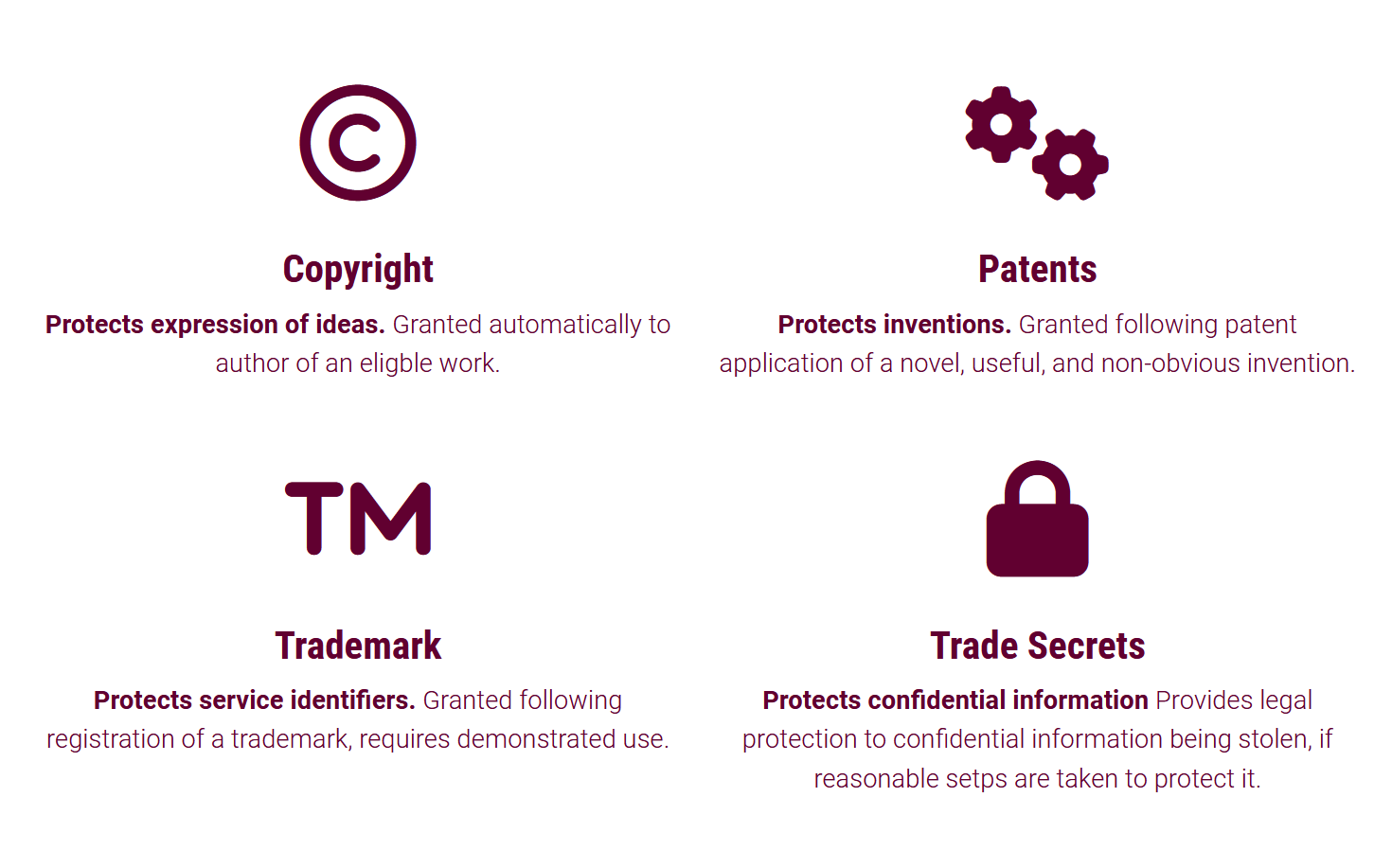What is Intellectual Property?
Briefly, Intellectual property (IP) is any form of knowledge or expression created with one’s intellect. It includes inventions such as computer software, trademarks, literary, artistic, musical, or visual works, trade secrets, and even know-how.
Unlike other types of physical property, such as real estate or a car, intellectual property is intangible and therefore requires special protections to prevent it from being stolen or misused.
As a result, possessing IP is associated with certain rights. IP rights are legal protections for your IP. They are an exclusive right that proves that you own the work and that it has become your property. Additionally, IP rights encourage innovation by providing creators such as inventors and designers with the exclusive right to prevent others from stealing or taking credit for their innovation.

Within Canada, the Canadian Intellectual Property Office (CIPO) is responsible for administering and processing most registered and enforceable IP rights.
Based on a federal statute, CIPO is responsible for granting IP protection, such as patents for inventions, trademarks for products, copyright for original works, among other types of IP.
Overview of IP Types
There are many different types of IP. Each one applies to different types of works and innovations and can be acquired and maintained in different ways. Having knowledge of different kinds of IP will enable you to make informed decisions about what types of IP to pursue and understand your rights better.
The most common types of IP that we use and encounter here at McMaster include:

Copyright – protects expressions of ideas and works and grants the sole right to reproduce or distribute a work to a copyright holder.
Patents – protect novel, unique inventions such as products, processes, machines, and chemical compositions; they can also apply to iterations on any of these that results in a useful improvement.
Trademarks – protect words and names, symbols, devices, or some combination of these that is used in commerce to identify and differentiate the goods or services of one seller from those sold by others.
Trade Secrets (Confidential Information) – any business information that derives value from its secrecy (such as formulas).
In addition, there are other specialized types of IP that can be employed if protection cannot be properly afforded by the aforementioned types. This includes:
- Industrial Designs which protect the unique appearance of a product.
- Integrated Circuit Topographies which protect the three-dimensional configurations of electronic circuits embodied in a product or design.
- Plant breeder’s rights which protect new varieties of plants, in a similar manner to how patents protect inventions.
However, applications for these are less general and McMaster, through the McMaster Industry Liaison Office (MILO), typically does not work with these types of IP.

Examples of IP at the University
In the context of university research, teaching, and learning, the following are just some examples of intellectual property that may be created by researchers, professors, and students:
- Educational/Teaching materials: courseware, presentations, videos, handbooks, software, notes, reviews, assignments/assessments.
- Patentable inventions: compositions of matter (e.g., drugs, alloys, biomaterials), devices (clinical diagnostics, medical devices, sensors), processes or methods (ways to manufacture or synthesize, business processes).
- Copyrightable works: software, mobile applications, databases, creative or artistic works, surveys, questionnaires, books, reports.
- Know-how: techniques, expertise, methods
In fact, you have almost certainly produced many kinds of IP while at McMaster, at other institutions, or on your own. After studying this topic, you will have a much clearer idea of what kinds of IP you may already have and what kinds of IP you may be interested in pursuing.

Why IP Matters?
Commercially, IP can increase your competitive edge over others by protecting a new product, a reputable brand, or a creative design that others don’t have. IP can also help build brand recognition and reputation with partners and customers.
Additionally, understanding your competitors’ IP can help you to:
- Avoid investing money and effort into activities or products that you don’t have the rights to.
- Focus the direction of your business toward gaps, openings, and trends in the marketplace.
- Avoid infringing on a competitor’s IP rights, such as patents.
- Determine when and where your competitors’ IP rights expire, so you can provide your own innovations on those ideas.
In addition to the commercial benefits, IP can also enhance the positive societal impact of inventions and works:
- IP encourages and rewards innovation. This can advance existing technologies, and even lead to breakthroughs.
- IP provides a safe and secure ways to distribute new technologies for inventors, allowing them to not just control their products but also prevent misuse.
- IP can encourage creativity and risk taking by giving artists, writers, and musicians legal rights and tools for their work.
- IP protection can help to preserve and protect traditional knowledge, cultural expressions, and resources of indigenous and local communities in Canada and internationally.
Summary
- Intellectual property (IP) is any form of knowledge or expression created with one’s intellect, and may be protected by copyright, patents, trademarks, as a trade secret, or using other forms of IP protection.
- These protections help IP holders to be commercially successful, better impact society, and reward innovation and creativity.
- Within McMaster, students and researchers are constantly producing and interacting with different types of IP.
- Understanding IP and IP protections is important to be commercially successful and to best impact society with your innovations and creations.
Register for Fundamentals of IP at McMaster Complete Course

Learn from enhanced and interactive lessons, get access to more content, and receive a certificate of completion.
These modules are created and facilitated by the McMaster Industry Liaison Office (MILO)
Disclaimer: The content of these modules provides general information regarding basic principles of intellectual property law and of commercialization. The content should not be taken as legal or professional advice. For specific advice, seek independent legal counsel.
McMaster University recognizes and acknowledges that it is located on the traditional territories of the Mississauga and Haudenosaunee nations, and within the lands protected by the “Dish with One Spoon” wampum agreement.
© McMaster Industry Liaison Office (MILO), all rights reserved, 2023. For more information, please visit: milo.mcmaster.ca
